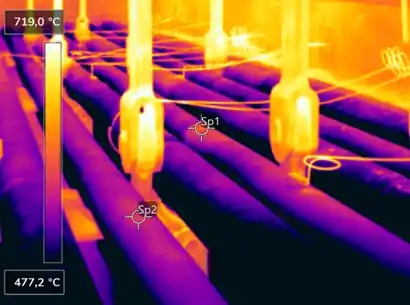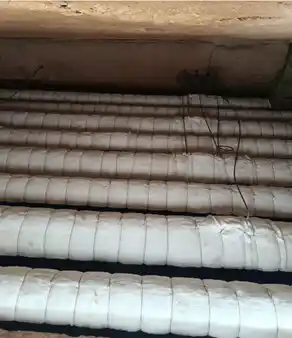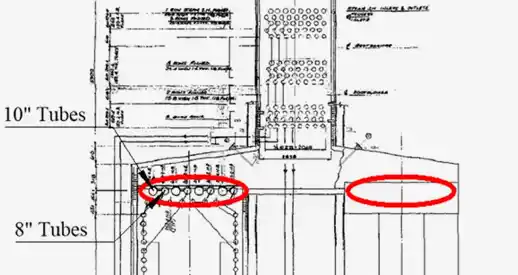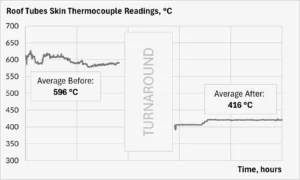Preventing Fired Heater Tube Overheating in Vacuum Units
Importance of Considering Phase Separation in Refinery Operations
One example is how phase separation in fired heater outlet tubes and transfer lines affects the predicted heater outlet temperature and the estimated liquid flow rates in the wash section. Neglecting this phenomenon can reduce the yield of gasoil products and lead to an excessively low wash oil flow rate. More critically, it may result in overheating of fired heater tubes in vapour-only regions with a low heat transfer coefficient, causing the actual tube metal temperature (TMT) to approach or exceed design limits. This is not just a matter of process efficiency but equipment safety and reliability, particularly in vacuum unit fired heaters.
Effects of Phase Separation on Fired Heater Performance
Most conventional models assume liquid-vapour equilibrium at the heater outlet, but in reality—especially after reducing vacuum pressure—liquid and vapour phases often separate before the transfer line. This leads to stratified flow, causing vapour to move through the top of the horizontal roof tubes. There, the vapour becomes superheated due to pressure drop. Since the upper part of the tubes doesn’t “see” flame, it doesn’t form oxidation scale, leaving it more exposed to the effects of overheating.
Image: Vacuum Heater Infrared Inspection: Sp1: 619 °C; Sp2: 592 °C.

Keeping that in mind, the sizeable gap between the actual process outlet temperature and tube metal temperature (>200°C) can be encountered, way exceeding the best design practices of no more than 80 °C or a maximum TMT of 500 °C.
This highlights the need for effective hot tube shielding and thermal insulation strategies.

IGS Ceramic Shielding Solution for Fired Heater Tube Protection
The IGS Thermal Efficiency Team was contacted by one of the global oil and gas supermajors to develop a solution. After multiple unsuccessful operational adjustments, IGS proposed a non-invasive fix that would avoid costly revamps during a planned shutdown.
Due to the large outer diameter (OD) of the vacuum heater outlet roof tubes (8” and 10”), phase separation caused hot spots due to poor heat transfer. IGS recommended proprietary ceramic Hot Tube Shielding technology, applied to the 180° circumferential surface of the roof tubes and secured with high-temperature wrapping wires. This thermal efficiency solution significantly reduced heat flux and prevented overheating without impacting downstream operations.
Project Goals: Reducing Heat Flux and Hot Spots
The objective of this project (Figures 4 & 5), according to the IGS evaluation, was to reduce heat flux from approximately 11000 to 1150 Btu/(ft2.hr) with a ca. 190oC tube wall temperature drop, entirely removing hot spots on the top part of these 8” and 10” tubes. The IGS operations team successfully completed all work within the heater over a three-shift period, finishing on time and within budget while prioritising safety as their foremost principle.

Measured Results: Performance Gains in Fired Heater Efficiency
IGS compared skin thermocouple readings before and after implementation. Results confirmed the success:
-
Average tube metal temperature dropped from 596 °C to 416 °C
-
Flue gas temperature entering the convection section rose by just 12 °C, without raising stack temperatures
This solution debottlenecked the vacuum heater, enabling increased throughput without TMT-related limitations or compromising thermal efficiency.
Image: Roof Tubes Skin Thermocouple Readings Before and After
Facing reliability issues with your fired heater tubes?
Talk to our IGS experts about implementing ceramic wrapping technology to optimize your heater performance and protect your assets.
Related Case Studies:
- Shutdown Prevented! Furnace Hot Spot Repair Saves $15 Million
- Fired Heater Shutdown Prevented with Hot Refractory Repair
- Hot Tube Stabilization During Crude Heater Operation
- Hot Spot Repair on a Live Fired Heater
- A Successful Revamp of a 40-year-old Steam-Methane Reformer Furnace
- IGS Helps Increases Thermal Efficiency by 3% at Tüpraş Izmir Refinery in Turkey
Watch: How IGS’ Solutions Increase Refinery Efficiency and Reduce Co2 Emissions
Free consultation with an IGS Subject Matter Expert
IGS is here to provide information, answer questions and create an effective solution for your needs.


